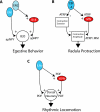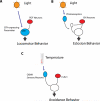Peptide neuromodulation in invertebrate model systems
- PMID: 23040808
- PMCID: PMC3466441
- DOI: 10.1016/j.neuron.2012.08.035
Peptide neuromodulation in invertebrate model systems
Abstract
Neuropeptides modulate neural circuits controlling adaptive animal behaviors and physiological processes, such as feeding/metabolism, reproductive behaviors, circadian rhythms, central pattern generation, and sensorimotor integration. Invertebrate model systems have enabled detailed experimental analysis using combined genetic, behavioral, and physiological approaches. Here we review selected examples of neuropeptide modulation in crustaceans, mollusks, insects, and nematodes, with a particular emphasis on the genetic model organisms Drosophila melanogaster and Caenorhabditis elegans, where remarkable progress has been made. On the basis of this survey, we provide several integrating conceptual principles for understanding how neuropeptides modulate circuit function, and also propose that continued progress in this area requires increased emphasis on the development of richer, more sophisticated behavioral paradigms.
Copyright © 2012 Elsevier Inc. All rights reserved.
Figures




References
Publication types
MeSH terms
Substances
Grants and funding
- R01GM085788/GM/NIGMS NIH HHS/United States
- R01NS055035/NS/NINDS NIH HHS/United States
- R01NS058443/NS/NINDS NIH HHS/United States
- R01MH067122/MH/NIMH NIH HHS/United States
- R01 GM085788/GM/NIGMS NIH HHS/United States
- R01 GM098931/GM/NIGMS NIH HHS/United States
- R21NS058330/NS/NINDS NIH HHS/United States
- R01 NS056443/NS/NINDS NIH HHS/United States
- R01 MH067122/MH/NIMH NIH HHS/United States
- R21 NS058330/NS/NINDS NIH HHS/United States
- R01 NS021749/NS/NINDS NIH HHS/United States
- R01GM098931/GM/NIGMS NIH HHS/United States
- R01 NS083875/NS/NINDS NIH HHS/United States
- R01NS021749/NS/NINDS NIH HHS/United States
- R01 NS055035/NS/NINDS NIH HHS/United States
LinkOut - more resources
Full Text Sources
Molecular Biology Databases

